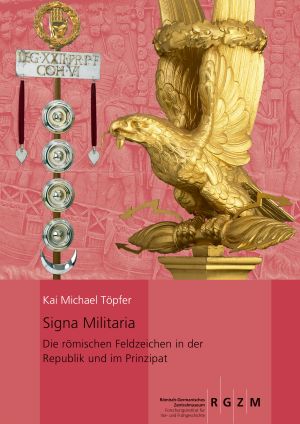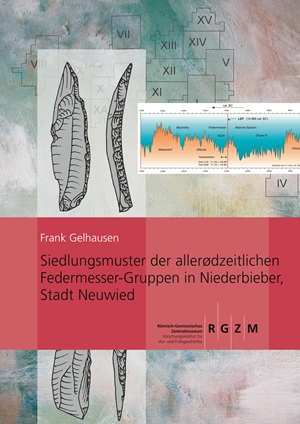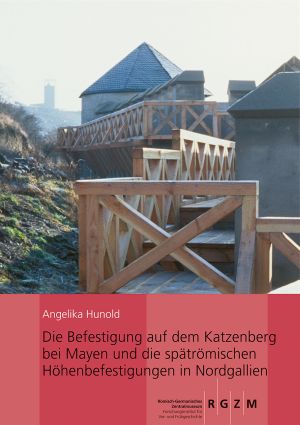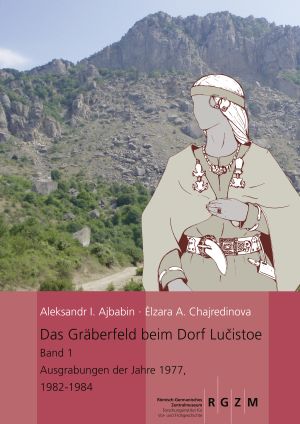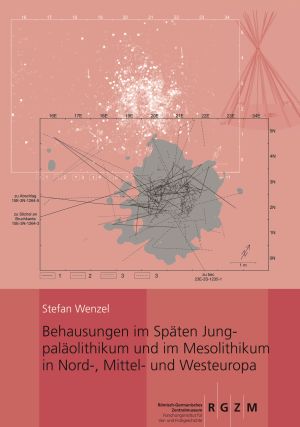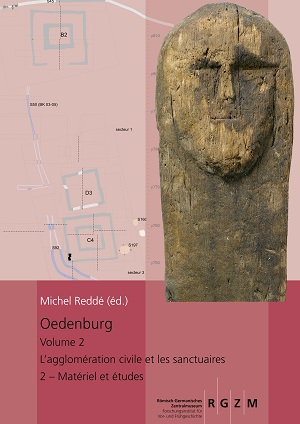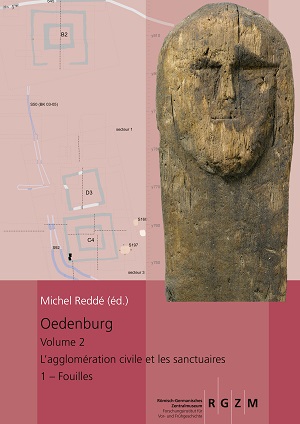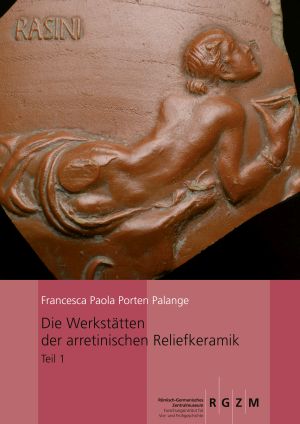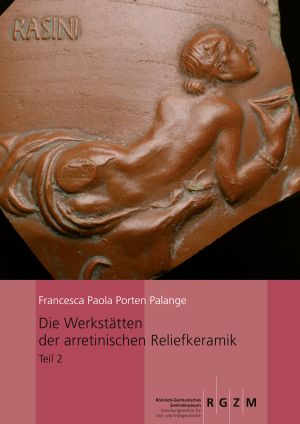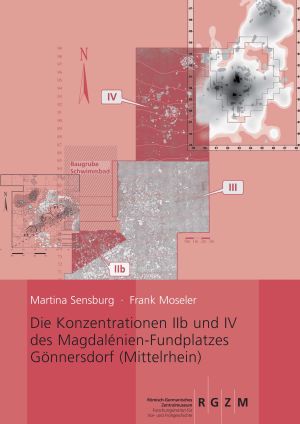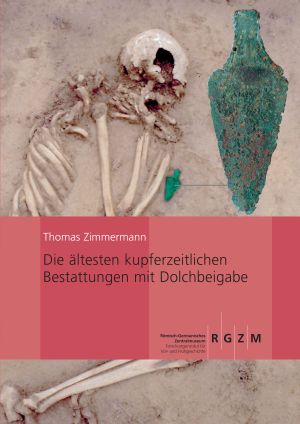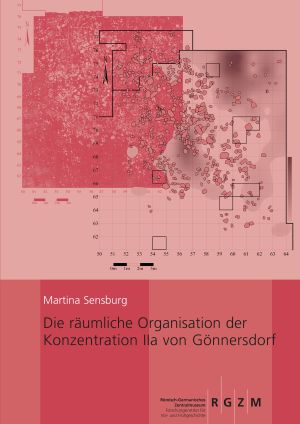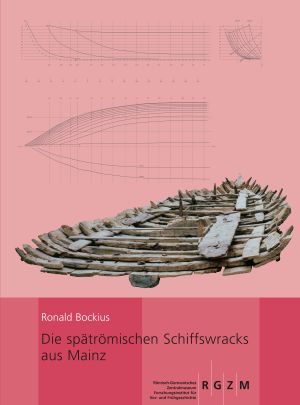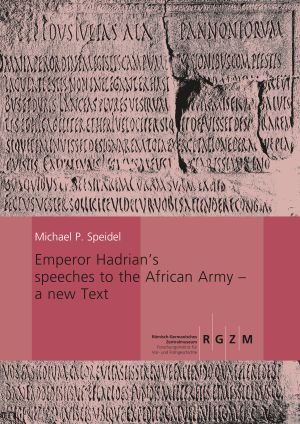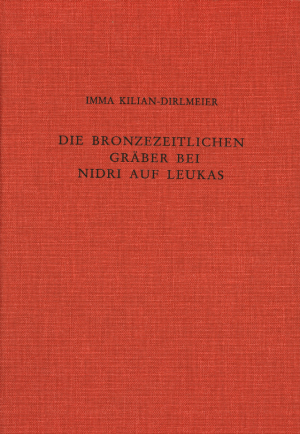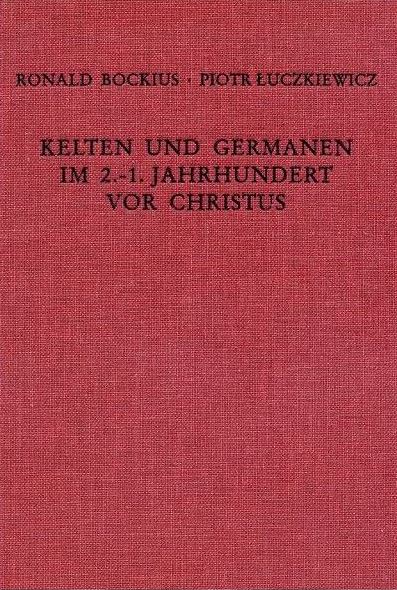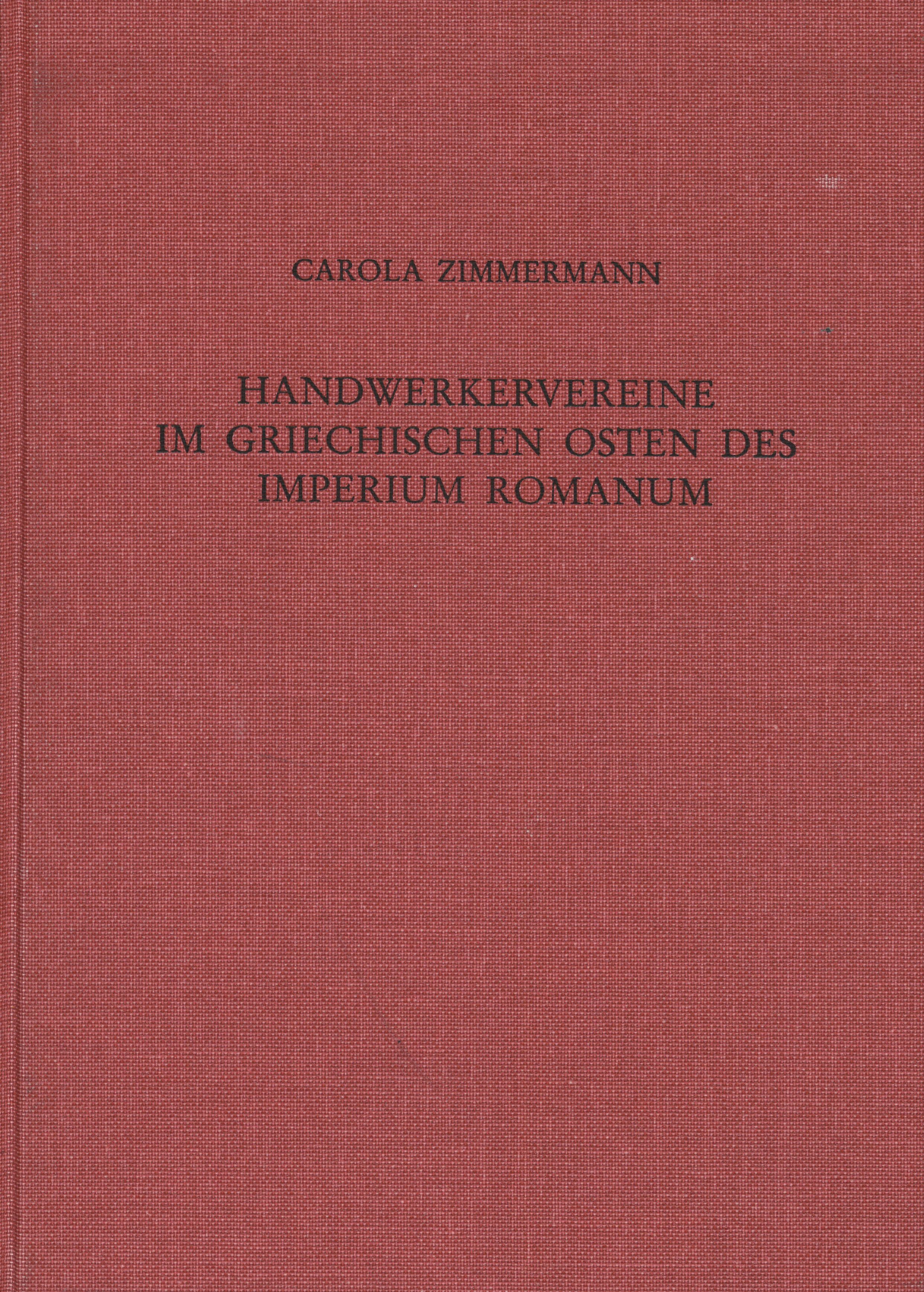Monographien des RGZM
In der Monographien-Serie des Römisch-Germanischen Zentralmuseums, Leibniz-Forschungsinstitut für Archäologie, werden auf der Grundlage archäologischer, historischer und literarischer Quellen übergreifende Fragestellungen zur prähistorischen, antiken und frühmittelalterlichen Geschichte, Kultur und Kunst behandelt. Ergänzende Materialien und Open Data können in die Online-Version aufgenommen werden.
Das Online-Angebot soll kontinuierlich durch die Retrodigitalisierung älterer Bände ergänzt werden.
Zusatzdaten zu Publikationen dieser Reihe
Italienische Übersetzung der Texte aus:
Joachim Weidig, Bazzano – ein Gräberfeld bei L’Aquila (Abruzzen). Die Bestattungen des 8.–5. Jahrhunderts v.Chr., Monographien des RGZM, Band 112 (Mainz 2014)
Weitere Publikationen des Römisch-Germanischen Zentralmuseums

Verlag
Leibniz-Zentrum für Archäologie
Ludwig-Lindenschmit-Forum 1
D-55116 Mainz
Tel.: +49 6131 8885 0
E-mail: verlag@rgzm.de
Bisher erschienen
Die Verbreitung von Terra Sigillata aus den Manufakturen von Arezzo, Pisa, Lyon und La Graufesenque: Die Transformation der italischen Sigillata-Herstellung in Gallien
In den letzten Jahrzehnten des 1. Jahrhunderts v. Chr. gründeten einige in Arezzo arbeitende Sigillata-Großproduzenten in Gallien Filialbetriebe für den dortigen Absatzmarkt. Schon bald verdrängten diese die Mutterfirmen aus dem Geschäft. Diesen Prozess dokumentieren 230 Verbreitungskarten.
Die Ausgründungen in Gallien werden in Zusammenhang mit der Entwicklung der wirtschaftlichen Großräume dargestellt. Sie führten zu einer Transformation dieser ursprünglich italischen Industrie, die sich auch in einem geänderten rechtlichen Status der Töpfer und Töpfereien in Gallien manifestiert. Darüber hinaus wurden die Transportkosten mittels GIS-Anwendungen ermittelt und in Karten dargestellt. Datierte Fundorte ermöglichen eine zeitliche Einordnung der behandelten Töpfer.
Signa Militaria: Die römischen Feldzeichen in der Republik und im Prinzipat
Die römische Armee verfügte über ein komplexes Signalwesen, das akustische und optische Hilfsmittel – Blasinstrument und Feldzeichen – für eine schnelle Übermittlung von Befehlen nutzte. Die hierbei verwendeten Standarten, die signa militaria, waren aber keine reinen Gebrauchsgegenstände, sie waren gleichzeitig bedeutende Sinnbilder der römischen Heeresmacht und wichtige Identifikationssymbole für die unter ihnen zusammengefassten Soldaten. Den Verlust eines solchen Feldzeichens empfanden nicht nur die Soldaten, sondern alle Römer als immense Schande.
In dem vorliegenden Band werden die Standarten des römischen Heeres auf Grundlage einer umfangreichen und reich bebilderten Materialsammlung, die neben zahlreichen antiken Darstellungen auch Inschriften und Fragmente originaler Feldzeichen umfasst, intensiv untersucht. Im Zentrum stehen dabei Fragen nach ihrem Aussehen, ihrer Verwendung sowie ihrem religiösen Status. Darüber hinaus werden die Standartenwiedergaben in der römischen Kunst auf ihre Detailtreue und ihre semantische Bedeutung hin befragt. Auf diese Weise entsteht ein vielschichtiges Gesamtbild der römischen Feldzeichen, die nicht nur in den Augen der Soldaten mehr als simple Orientierungshilfen auf dem Schlachtfeld waren.
Siedlungsmuster der allerødzeitlichen Federmessergruppen in Niederbieber, Stadt Neuwied
Der Ausbruch des Laacher See-Vulkans um 11000 v. Chr. hat mit einer mächtigen Bimsdecke die Landschaft am Mittelrhein versiegelt. In einer unvergleichlichen Momentaufnahme blieben so das Geländerelief, die Reste von Vegetation und Fauna erhalten, dazu viele Hinweise auf die Nutzung der Region durch den Menschen.
Der Fundplatz Niederbieber ist dabei für archäologische Untersuchungen von herausragender Bedeutung. Hier konnte auf einer ca. 1000 m2 großen Fläche eine beträchtliche Zahl von Fundkonzentrationen freigelegt werden, die Einblick in die sonst kaum zu fassenden Siedlungsprozesse der späteiszeitlichen Federmesser-Gruppen ermöglichen.
Der Autor hat in seinem Buch die Funde und Befunde des zentralen Flächenteils von Niederbieber analysiert. Die Ergebnisse seiner Untersuchungen liefern neue Erkenntnisse über die vor Ort ausgeführten Tätigkeiten, die Belegungsdauer der Fundkonzentration sowie die Lebensweise der Menschen am Ende der Eiszeit.
Die Befestigung auf dem Katzenberg bei Mayen und die spätrömischen Höhenbefestigungen in Nordgallien
Auf dem Katzenberg bei Mayen bestand von etwa 300 n. Chr. bis in die Mitte des 5. Jahrhunderts zum Schutz des Wirtschaftszentrums Mayen eine militärische Befestigung, die zu den größten ihrer Art gehört.
Ausgehend von den dort gewonnenen Ergebnissen werden 143 weitere Höhenbefestigungen in Nordgallien untersucht. An Verkehrswegen orientiert, vor allem an den Wasserstraßen, besitzen diese Anlagen keineswegs den Charakter versteckter Refugien. Vielmehr können auch sie als Militäranlagen eingestuft werden, die in ein übergreifendes Verteidigungskonzept eingebunden waren. Sie sicherten den Fortbestand des zivilen und wirtschaftlichen Lebens im ländlichen Raum. Somit bilden Höhenbefestigungen eines der Elemente einer tief gestaffelten militärischen Sicherung in der Spätantike.
Tiere im Byzantinischen Reich
Das Byzantinische Reich (395-1453 n.Chr.) ist seit Langem Gegenstand geisteswissenschaftlicher Untersuchungen. Vor allem die zahlreich vorliegenden Schriftquellen bildeten die Basis, um politische, wirtschaftliche und soziokulturelle Entwicklungen dieser Zeit zu rekonstruieren. Über ganz alltägliche Dinge des Lebens schweigen die Schriftquellen jedoch weitgehend: Sie erschienen nicht erwähnenswert. Dazu zählt auch die Ernährung. Umfassende Arbeiten von naturwissenschaftlicher Seite sind bestens geeignet, um speziell diese Lücke zu schließen und die anhand der Schriftquellen gewonnenen Ergebnisse abzusichern.
Als ein erster Schritt in diese Richtung fasst der vorliegende Band den Status quo der Archäozoologie für das Byzantinische Reich zusammen. Es wird aufgezeigt, welche Erkenntnisse über die byzantinische Viehzucht, die Jagd, den Vogelfang und die Fischerei bereits vorliegen und welche kulturellen, historischen oder ökogeografischen Faktoren diese Wirtschaftszweige in den Provinzen jeweils beeinflussten. Die regionalen und zeitlichen Unterschiede finden ebenso Beachtung wie die Gemeinsamkeiten, dazu auch der Stellenwert der römischen Tradition sowie die Rolle, die das Christentum für die Ernährung spielte.
Das Gräberfeld beim Dorf Lučistoe
Das Gräberfeld beim Dorf Lučistoe an der Südküste der Krim ist ein einzigartiges historisches Denkmal der Völkerwanderungszeit. Von 1982-2007 wurden hier 295 Gräber des 5.-18. Jahrhunderts untersucht. Mit dem erschlossenen Quellenmaterial ist es erstmals möglich, die Bevölkerung aus dem Bergland der Krim über einen derart langen Zeitraum zu erforschen. Mit dem vorliegenden Band eröffnet das RGZM die Herausgabe des Gräberfeldes von Lučistoe, das für die Geschichte der Krim und Osteuropas von großer Bedeutung ist. Ein ausführlicher Kommentar vermittelt die chronologische und kulturgeschichtliche Einordnung der Forschungsergebnisse.
Behausungen im Späten Jungpaläolithikum und im Mesolithikum in Nord-, Mittel- und Westeuropa
Wo in der Zeit von 15000-5000 v. Chr. Jäger und Sammler in den Steppen und Wäldern Europas ihr Lager aufschlugen, blieben meist in großer Zahl Steinartefakte und Herdsteine zurück. Nur selten aber sind Wohnbauten anhand von erhaltenen Konstruktionselementen direkt nachweisbar.
In diesem Buch werden sechs Fundkonzentrationen daraufhin untersucht, ob es Indizien dafür gibt, daß ehemals Zeltwände einer diffusen Verteilung der Steinabfälle nach außen hin als Hindernis im Weg standen: Orp Ost und Rekem 10 in Belgien, Cepoy im Pariser Becken, Geldrop 3-2 in den südlichen Niederlanden, Berlin-Tegel IX sowie Hartmannsdorf 26 in Brandenburg. Bei diesen Siedlungsstrukturen wie bei den zum Vergleich herangezogenen Wohnbauten und nicht überdachten Lagerplätzen dieses Zeitabschnitts lassen sich ferner Arbeitsbereiche rekonstruieren, die Aussagen zur Organisation der jeweiligen lokalen Gruppen erlauben.
Zillingtal (Burgenland) – Die awarenzeitliche Siedlung und die Keramikfunde des Gräberfeldes: Teil 2
Die Bearbeitung der frühmittelalterlichen Siedlung (7.-8. Jahrhundert n. Chr.) sowie der Keramikfunde des zugehörigen Gräberfeldes konzentriert sich auf drei Schwerpunkte: awarenzeitliche Siedlungsbefunde und Siedlungsstrukturen im Karpatenbecken, Keramikproduktion und Keramikgebrauch in der Awarenzeit sowie awarenzeitliche Traditionen in Zillingtal bei der Beigabe von Keramikgefäßen ins Grab.
Bei den Siedlungsbefunden interessiert vor allem die frühmittelalterliche Wiederverwendung der römischen Ruinen. Die Auswertung des Fundmaterials konzentriert sich auf die Keramikfunde, mit denen zusammen auch die Keramikgefäße des awarenzeitlichen Gräberfeldes untersucht werden. Dazu dienen archäologische und archäometrische Analysen sowie Methoden der experimentellen Archäologie. Die gewonnene Chronologie der Grabgefäße und die anthropologischen Daten der Bestatteten bilden die Basis für die Analyse der awarenzeitlichen Traditionen bei der Beigabe von Keramikgefäßen in die Gräber.
Teil 1 hier.
Zillingtal (Burgenland) – Die awarenzeitliche Siedlung und die Keramikfunde des Gräberfeldes: Teil 1
Die Bearbeitung der frühmittelalterlichen Siedlung (7.-8. Jahrhundert n. Chr.) sowie der Keramikfunde des zugehörigen Gräberfeldes konzentriert sich auf drei Schwerpunkte: awarenzeitliche Siedlungsbefunde und Siedlungsstrukturen im Karpatenbecken, Keramikproduktion und Keramikgebrauch in der Awarenzeit sowie awarenzeitliche Traditionen in Zillingtal bei der Beigabe von Keramikgefäßen ins Grab.
Bei den Siedlungsbefunden interessiert vor allem die frühmittelalterliche Wiederverwendung der römischen Ruinen. Die Auswertung des Fundmaterials konzentriert sich auf die Keramikfunde, mit denen zusammen auch die Keramikgefäße des awarenzeitlichen Gräberfeldes untersucht werden. Dazu dienen archäologische und archäometrische Analysen sowie Methoden der experimentellen Archäologie. Die gewonnene Chronologie der Grabgefäße und die anthropologischen Daten der Bestatteten bilden die Basis für die Analyse der awarenzeitlichen Traditionen bei der Beigabe von Keramikgefäßen in die Gräber.
Teil 2 hier.
Oedenburg: Volume 3: L’agglomération civile (fouilles 2009-2012)
Der dritte Band der Grabungspublikation von Oedenburg analysiert zwei zivile Siedlungsareale in der Nähe des valentinianischen Kastells Altkirch, mit einer Besiedlungsstratigraphie von der tiberischen Zeit bis zum Beginn des 5. Jahrhunderts mit einer Unterbrechung von etwa 50 Jahren ab etwa 270/280. Er enthält außerdem Studien zur Keramik, zu den Münzen, den merowingischen Waffen sowie zu Metallwerkstätten, Palynologie, Archäobotanik und Fauna.
Oedenburg: Volume 2: L’agglomération civile et les sanctuaires 2 – Matériel et études
Der zweite Teil über die Ausgrabungen in Oedenburg stellt die Untersuchungen auf unterschiedlichen Gebieten der Zivilsiedlung dar. Die Vielfalt der ergrabenen Zonen sowie eine sehr großflächige geomagnetische Prospektion erlauben, einen räumlichen Ansatz der zivilen Agglomeration vorzulegen sowie ihren chronologischen Ablauf und das Niveau der materiellen Entwicklung zu bewerten.
Oedenburg: Volume 2: L’agglomération civile et les sanctuaires 1 – Fouilles
Der zweite Teil über die Ausgrabungen in Oedenburg stellt die Untersuchungen auf unterschiedlichen Gebieten der Zivilsiedlung dar. Die Vielfalt der ergrabenen Zonen sowie eine sehr großflächige geomagnetische Prospektion erlauben, einen räumlichen Ansatz der zivilen Agglomeration vorzulegen sowie ihren chronologischen Ablauf und das Niveau der materiellen Entwicklung zu bewerten.
Oedenburg: Volume 1: Les camps militaires julio-claudiens
Der erste Band der Abschlusspublikation befasst sich mit der Analyse der Architektur und der historischen Bedeutung des römischen Lagers, das unter Tiberius an der Grenze des Reiches errichtet wurde, bevor es unter Claudius wieder aufgebaut und nach der Eroberung des Dekumatenlandes (agri decumates) verlassen wurde.
Die Werkstätten der arretinischen Reliefkeramik: Teil 1
Dem »Katalog der Punzenmotive in der arretinischen Reliefkeramik« (RGZM Kataloge Vor- und Früh geschichtlicher Altertümer 38, 1-2 [2004]) folgen nun diese beiden Bände über die Werkstätten, die von ca. 30 v.Chr. an in Arezzo und Umgebung Reliefkeramik produziert haben.
Im ersten Band werden insgesamt 22 Werkstätten analysiert, ergänzt durch ein Kapitel über den Töpfer Anteros, von dem wir noch nicht wissen, für welche Manufaktur er gearbeitet hat. Die Werkstätten sind völlig neu bearbeitet, und ihr Repertoire ist umfassender beschrieben. Hinzu kommen viele bis dato unbekannte Punzenmotive sowie gegenüber der bisherigen Forschung notwendige Neuzuweisungen, wodurch wir – obwohl das Material des Museums in Arezzo immer noch so spärlich veröffentlicht bleibt – von der Gattung ein deutlich klareres und genaueres Bild erhalten und das Repertoire der einzelnen Offizinen an Reichhaltigkeit gewinnt.
Der zweite Band enthält für jede Werkstatt in zeichnerischer Darstellung die Namensstempel und die bislang bekannten Profile, außerdem die wichtigsten Randmotive und die häufigsten vegetabilischen Ornamente, die für die korrekte und sichere Zuschreibung eine so entscheidende Rolle spielen. Ebenso sind – um die im ersten Band beschriebenen Figurenreihen besser nachvollziehen zu können – auch die bedeutungsvollen Zyklen anhand zahlreicher Bildkombinationen sowie bislang singulär überlieferte Zusammensetzungen figürlicher und ornamentaler Motive dargestellt.
Zu Band 2
Die Werkstätten der arretinischen Reliefkeramik: Teil 2
Dem »Katalog der Punzenmotive in der arretinischen Reliefkeramik« (RGZM Kataloge Vor- und Früh geschichtlicher Altertümer 38, 1-2 [2004]) folgen nun diese beiden Bände über die Werkstätten, die von ca. 30 v.Chr. an in Arezzo und Umgebung Reliefkeramik produziert haben.
Im ersten Band werden insgesamt 22 Werkstätten analysiert, ergänzt durch ein Kapitel über den Töpfer Anteros, von dem wir noch nicht wissen, für welche Manufaktur er gearbeitet hat. Die Werkstätten sind völlig neu bearbeitet, und ihr Repertoire ist umfassender beschrieben. Hinzu kommen viele bis dato unbekannte Punzenmotive sowie gegenüber der bisherigen Forschung notwendige Neuzuweisungen, wodurch wir – obwohl das Material des Museums in Arezzo immer noch so spärlich veröffentlicht bleibt – von der Gattung ein deutlich klareres und genaueres Bild erhalten und das Repertoire der einzelnen Offizinen an Reichhaltigkeit gewinnt.
Der zweite Band enthält für jede Werkstatt in zeichnerischer Darstellung die Namensstempel und die bislang bekannten Profile, außerdem die wichtigsten Randmotive und die häufigsten vegetabilischen Ornamente, die für die korrekte und sichere Zuschreibung eine so entscheidende Rolle spielen. Ebenso sind – um die im ersten Band beschriebenen Figurenreihen besser nachvollziehen zu können – auch die bedeutungsvollen Zyklen anhand zahlreicher Bildkombinationen sowie bislang singulär überlieferte Zusammensetzungen figürlicher und ornamentaler Motive dargestellt.
Zu Band 1
Römischer Basaltlava-Abbau zwischen Eifel und Rhein
Zwischen den Städten Andernach am Rhein und Mayen in der Eifel bestand bereits in der Antike eines der großen Abbaureviere für mineralische Rohstoffe. Produkte aus Basaltlava – allen voran qualitätvolle Mühlsteine – entwickelten sich in römischer Zeit zu regelrechten Exportschlagern. Über den Rhein im großen Stil verhandelt, fanden sie ihre Abnehmer in Britannien ebenso wie im Voralpenland.
Im Mittelpunkt der Untersuchung stehen die Mühlsteinbrüche am Bellerberg-Vulkan bei Mayen. Neue Ausgrabungen und Prospektionen im Rahmen des Vulkanpark Osteifel-Projektes ermöglichen eine detaillierte Rekonstruktion der Produktionsabläufe und zeigen eine hochgradige Arbeitsteilung. Modellrechnungen unter Einbeziehung aller Funde und Befunde auch aus vor- und nachrömischen Epochen erlauben Quantifizierungen der ökonomischen Prozesse. Eine Synthese aller vergleichbaren Abbaureviere in der Alten Welt rundet die Studie ab.
Die Konzentrationen IIb und IV des Magdalénien-Fundplatzes Gönnersdorf (Mittelrhein)
Der Magdalénien-Fundplatz Gönnersdorf bietet aufgrund seines Fundreichtums und der außergewöhnlich guten Erhaltung einzigartige Möglichkeiten der räumlichen Analyse eines jungpaläolithischen Siedlungsareals. Während die Konzentration IV bereits Gegenstand einer 1997 erschienenen Untersuchung war, handelt es sich bei Konzentration IIb um eine bislang unerforschte Siedlungsstruktur.
Die Konzentration IIb stellt eine Teilfläche der Großkonzentration II dar, deren zentrale Siedlungsstruktur (Konzentration IIa) bereits 2007 ausführlich behandelt wurde (Monogr. RGZM 69). Im Vordergrund steht nun, die Funktion der Siedlungsstrukturen in Konzentration IIb zu klären sowie ihr zeitliches und räumliches Verhältnisses zu den benachbarten Konzentrationen IIa und III.
Eine erneute räumliche Analyse von Konzentration IV erschien sinnvoll, da sich besonders digitale Analyseverfahren seit der Erstbearbeitung erheblich verfeinert haben, und nun einige vormals unbehandelte Teilaspekte untersucht werden konnten. Das führte hinsichtlich der Beziehung zwischen latenten und evidenten Befunden sowie der Artefaktherstellung in K–IV zu detaillierten Ergebnissen.
Die ältesten kupferzeitlichen Bestattungen mit Dolchbeigabe
Hauptziel dieser Studie ist die Erfassung und Analyse einschlägiger geschlossener Einzelgrabbefunde mit hauptsächlich Silex- oder Metalldolchbeigabe des dritten Jahrtausends v. Chr. Um sich diesem Problemkomplex jedoch möglichst umfänglich zu nähern, wurden auch die frühesten Belege zweischneidiger Stichwaffen Ost- Südosteuropas sowie Westkleinasiens in ihrem grabrituellen Umfeld mit berücksichtigt. Auch der frühen Dolchherstellung im prädynastischen Ägypten ist ein größerer Exkurs gewidmet. Neben der Diskussion chronologischer Aspekte dieser Bewaffnungssitte steht die Frage nach der Genese und Verbreitung formaler und technologischer Traditionen dieser Waffengattung im Zentrum unseres Interesses. Wichtig ist in diesem Zusammenhang natürlich die Frage, ob und wie sich der dolchtragende Bevölkerungsteil im Grabritus von zeitgleichen Grablegen ohne Stichwaffenbeigabe unterscheidet. Dies führt letztendlich zu sozialgeschichtlichen Überlegungen, inwiefern der Dolch generell als statusbildendes Zubehör verstanden werden darf.
Die räumliche Organisation der Konzentration IIa von Gönnersdorf
Der Magdalénien-Fundplatz Gönnersdorf repräsentiert einen der europaweit seltensten Siedlungsbefunde des späten Jungpaläolithikums. Seine außergewöhnliche Erhaltung ermöglicht seit seiner Entdeckung 1968 einen beständigen Erkenntniszuwachs in Hinblick auf die Lebensweise eiszeitlicher Jäger und Sammler. So erfolgte bereits die grundlegende Untersuchung der Siedlungsstrukturen in den Großkonzentrationen I, III und IV. Die Behandlung der zentralen und zugleich fundreichsten Konzentration IIa stand bislang jedoch noch aus. Mit der vorliegenden Arbeit kann diese Lücke nun geschlossen werden.
Der Schwerpunkt der Analysen von K IIa liegt v.a. auf einer Rekonstruktion der alltäglichen Aktivitäten der ehemaligen Bewohner. Hierzu wird die räumliche Beziehung latenter Fundverteilungen zu den evidenten Befunden, wie dem zentralen Behausungsgrundriß, den Gruben und den Feuerstellen, ausführlich diskutiert. Hieraus sowie aus den Zusammensetzungsanalysen ergeben sich schließlich entscheidende Hinweise, die zu der Entwicklung eines gänzlich neuen Besiedlungsmodells, nicht nur für K IIa, sondern für den gesamten Fundplatz führen.
Die spätrömischen Schiffswracks aus Mainz: Schiffsarchäologisch-technikgeschichtliche Untersuchung spätantiker Schiffsfunde vom nördlichen Oberrhein
Als einzige Vertreter ihrer Art werfen die Schiffsfunde aus Mainz neues Licht auf die spätrömische Militärgeschichte. Ihr Erhaltungszustand gewährt Einblick in teils komplexe bootsbauliche Verfahrenstechniken und Maßnahmen, aus denen Verflechtungen mit dem romano-keltischen Seeschiff Nordwesteuropas hervorgehen; zugleich ist auch mediterranes Know-how erkennbar. Spuren des antiken Vermessungs- und Konstruktionswesens künden von besonderen planerischen und arbeitsorganisatorischen Leistungen. Überdies bietet sich nirgendwo sonst so umfassend Gelegenheit zur strukturellen Untersuchung römerzeitlicher Riemenantriebssysteme und wie sie mit dem Menschen zusammenwirken.
Als schiffsarchäologisch-technikgeschichtliche Auswertung angelegt und komparativ weit ausgreifend, erschließt das Buch eine sowohl chronologisch als auch schiffstypologisch differenzierende Neuordnung des Fundstoffs. Eine akribische Dokumentation in Wort und Bild bildet die Grundlage für Planrekonstruktionen, die Form, Größe, Ausstattung und die Verwendbarkeit der Fahrzeuge nachzeichnen.
Emperor Hadrian’s speeches to the African Army – a new text
Im Sommer 128 begab sich Kaiser Hadrian (117-139) nach Numidien, um die Kampffähigkeiten der afrikanischen Armee Roms zu überprüfen. In Reden an die Truppen bewertete er die Manöver, deren Zeuge er wurde. Anschließend hielt die Armee die Reden in einer Inschrift auf dem Exerzierplatz in Lambaesis fest. Obwohl diese Reden gekürzt und durch Lücken unterbrochen wurden, sind sie die einzigen erhaltenen Reden eines antiken Kaisers an seine Soldaten und bieten daher einen einzigartigen Einblick in die Ausbildung und die Kampffähigkeiten der römischen Armee.
Das Ziel dieses Buches ist es, so viel wie möglich von Hadrians Reden wiederherzustellen, die Struktur der Inschrift wiederherzustellen und einen kohärenten Text zu schaffen, damit Hadrians Worte durch die Jahrtausende hindurch wieder erklingen können.
Die bronzezeitlichen Gräber bei Nidri auf Leukas: Ausgrabungen von W. Dörpfeld 1903-1913
Diese Monographie ist eine Neubearbeitung der von W. Dörpfeld ausgegrabenen und publizierten bronzezeitlichen Gräber in der Nidri-Ebene auf der Insel Leukas (Levkada). Dazu wurde zusätzlich Dörpfelds Dokumentation in Tagebüchern, Notizheften und mit Photographien ausgewertet. Damit ergeben sich neue Einsichten in die Grabarchitektur, die Grabinventare, die Belegungsabfolge und soziale Strukturen nicht nur der Rundgräber der R-Nekropole, sondern auch des Grabhügels S und des Gräberbezirks F. Die Provenienz der Grabbeigaben ist Evidenz für weitreichende Kontakte mit den Kykladen, der Schwarzmeerregion, dem griechischen Festland und Gebieten an der Ostküste der Adria. Es stellt sich die Frage, welches die entscheidenden Faktoren waren, auf denen Macht und Reichtum der Elitte auf einer kleinen Insel an der Peripherie der ägäischen FH II-Kultur beruhten.
Kelten und Germanen im 2.-1. Jahrhundert vor Christus: Archäologische Bausteine zu einer historischen Frage
Mit der Studie wird das Ziel verfolgt, die Wesenszüge der Grabrepräsentation der ritterlichen und senatorischen Bevölkerungsgruppe im Untersuchungsgebiet und -zeitraum anhand archäologisch-epigraphischer Zeugnisse aufzuzeigen. Dabei wird der Frage nachgegangen, ob es verbindliche Formen der Grabrepräsentation innerhalb dieser zwei Gesellschaftsgruppen gab, und welcher Art sie waren. Ebenso werden die erfassten Repräsentationsformen bezüglich der zusammenhängenden Intention und / oder Aussageabsicht analysiert und interpretiert. Materielle Basis der Studie bildet ein umfangreicher Katalog neu bearbeiteter oder bis jetzt nicht publizierter, sepulkraler Denkmäler beider Personengruppen.
Handwerkervereine im griechischen Osten des Imperium Romanum
Die Autorin untersucht Belege für Handwerkervereine im griechischen Osten während der gesamten römischen Kaiserzeit. Herangezogen werden dazu v.a. epigraphische und papyrologische Quellen.
Das spätkeltische Wagengrab von Boé (Dép. Lot-et-Garonne): Studien zu Wagen und Wagengräbern der jüngeren Latènezeit
1959 wurde in Aquitanien beim Oppidum Agen ein Komplex entdeckt, der als reiches Grab identifiziert werden konnte; eine Nachgrabung von R. Boudet bestätigte dies 1990. Das Grab kann wohl einem rex der Nitiobrogen zugewiesen werden, der ca. 50-35 v. Chr beigesetzt wurde. Die Keramik umfasst Amphoren (Dressel 1B, Lamboglia 2), italische (u.a. Campana B) und einheimische Formen. Die Metallfunde sind außergewöhnlich reich. Ein vierrädriger Prunkwagen, dessen Konstruktion der von Dejbjerg ähnelt, konnte rekonstruiert werden. Wagen stellen seit der Bronzezeit wichtige Bestandteile reicher Gräber dar. Wagenfunde aus Latène C/D wurden für Mitteleuropa gesammelt und methodisch analysiert; die Gräber wurden in ihren Kontext eingeordnet.




